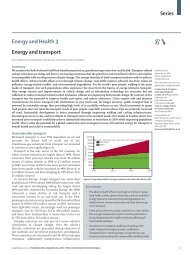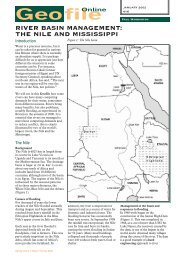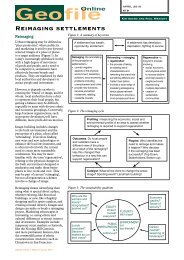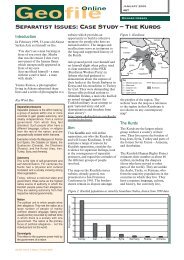Geofile Online - Richmond School District No. 38
Geofile Online - Richmond School District No. 38
Geofile Online - Richmond School District No. 38
You also want an ePaper? Increase the reach of your titles
YUMPU automatically turns print PDFs into web optimized ePapers that Google loves.
January 2009 no.581 Ecotowns<br />
is the developer’s offer to fund the<br />
long awaited East–West Rail Link to<br />
Milton Keynes, which is estimated<br />
to cost £190m.<br />
Labour’s Housing Minister at the<br />
time, Caroline Flint, claimed that<br />
a key and indeed fundamental<br />
component of the scheme is the<br />
delivery of the East–West Rail Link.<br />
A new station will be built at Weston<br />
Otmoor. Up to five trains per hour<br />
in each direction (to Oxford in six<br />
minutes) will be provided. A chord<br />
line to Bicester will mean a one hour<br />
journey time to London.<br />
Residents would be provided with<br />
free tram and bus services around<br />
the town and into Oxford, with<br />
developers also proposing a large<br />
park-and-ride that will ‘take car traffic<br />
away from the motorway junction and<br />
will provide a quicker, more direct<br />
alternative for car commuters to<br />
Oxford’.<br />
Shipton Quarry<br />
Plans were also submitted to create an<br />
ecotown in a disused quarry north of<br />
Kidlington (Figure 3). The scheme<br />
planned to create at least 5,000 homes<br />
in a self-sustained community at<br />
Shipton Quarry. It was one of only<br />
about 30 schemes to have been<br />
submitted to the Government.<br />
Kilbride Properties were hopeful<br />
of meeting conditions set out in a<br />
Government prospectus for new<br />
settlements required ‘to achieve<br />
zero carbon development and more<br />
sustainable living’.<br />
The Shipton Quarry scheme shows<br />
schools, shops, sports facilities,<br />
businesses, a new rail station, a parkand-ride<br />
site, marina and nature<br />
reserve. Kilbride believes a scheme to<br />
transform the former cement works<br />
into a thriving community is in tune<br />
with government calls for sites with<br />
‘separate and distinct identity but<br />
good links to surrounding towns and<br />
cities in terms of jobs, transport and<br />
services’.<br />
the Oxfordshire campaign manager<br />
for the Campaign to Protect Rural<br />
England expressed grave concerns<br />
about Shipton Quarry as a site.<br />
He stated that the greatest problem<br />
was traffic. The surrounding roads are<br />
already clogged. Having thousands of<br />
people travelling to and from there,<br />
with a large park-and-ride, would<br />
make the situation far worse. There is<br />
no infrastructure for it.<br />
The Cambridge Challenge<br />
Cambridge’s hi-tech industry has<br />
had a major economic impact for the<br />
region and the national economy,<br />
but it has resulted also in a shortage<br />
of housing and soaring house prices.<br />
The lack of housing in the area is a<br />
major inhibitor to further economic<br />
development, and about 50,000 new<br />
homes are planned to be built there<br />
by 2020.<br />
The ‘Cambridge Challenge’ is a pilot<br />
scheme to develop and manage new<br />
affordable homes for three of the<br />
major growth sites in Cambridge.<br />
The three sites will provide a total<br />
of 16,000 homes by 2021, of which<br />
around 6,000 (nearly 40%) will be<br />
affordable. One of these sites is the<br />
new settlement of <strong>No</strong>rthstowe.<br />
<strong>No</strong>rthstowe is five miles north-west<br />
of Cambridge, on the route of the<br />
new Cambridgeshire Guided Bus.<br />
It has been earmarked as a new<br />
community of 9,500 homes on the<br />
former RAF Oakington barracks<br />
and airfield, and is intended to be a<br />
flagship of sustainability in the use<br />
of renewable energy sources, the<br />
minimisation of carbon emissions and<br />
the implementation of environmental<br />
best practice on waste and water<br />
management.<br />
<strong>No</strong>rthstowe is intended to include:<br />
• a secondary school, six primary<br />
schools and a civic hub including<br />
community health and cultural<br />
facilities;<br />
• a local business district providing<br />
5,000 jobs;<br />
• leisure facilities; and<br />
• shopping facilities suitable for a<br />
small town.<br />
<strong>No</strong>rthstowe is looking to achieve<br />
up to 50 per cent reductions in<br />
energy and mains water use by using<br />
approaches such as:<br />
• microgeneration, photovoltaic<br />
panels;<br />
• solar water heating (can supply up<br />
to 50 per cent hot water); and<br />
• design for reduced energy and<br />
water use.<br />
Conclusion<br />
On paper, ecotowns look<br />
environmentally friendly. However,<br />
whether they are economically viable,<br />
and therefore environmentally viable,<br />
is a big question. The case studies<br />
in this unit illustrate some of the<br />
issues connected to ecotowns. The<br />
ecotown concept reignites some of<br />
the concerns regarding new towns<br />
- would they work, where should<br />
they be located, and what impacts<br />
will they have On the one hand,<br />
the range of technological measures<br />
designed to minimise environmental<br />
impact is impressive. On the other<br />
hand, the term ‘ecotown’ may just be<br />
a label to appease the environmentally<br />
minded and hide the fact that these<br />
places are too small for self-sustaining<br />
economic growth, and will depend<br />
on commuting to large urban areas<br />
nearby, thus merely exacerbating<br />
current environmental issues.<br />
Websites<br />
http://www.communities.gov.<br />
uk/documents/housing/pdf/<br />
livinggreenerfuture, for the<br />
background on the 15 sites to have<br />
made the short-list.<br />
http://www.communities.gov.uk/news/<br />
corporate/newecotownscould, for<br />
ecotowns and climate change.<br />
A recent report by planning<br />
inspectors on housing numbers<br />
in the South East expressed little<br />
enthusiasm for thousands of homes at<br />
Shipton Quarry, arguing that it would<br />
exacerbate existing traffic problems.<br />
Shipton is an interesting location. It is<br />
a large site that would go some way to<br />
easing the housing shortage. However,<br />
F o c u s<br />
Q u e s t i o n s<br />
1. Describe the distribution of ecotowns as shown on Figure 1.<br />
2. Outline the advantages and disadvantages of ecotowns.<br />
3. Decide whether ecotowns are a positive policy or not, and justify your<br />
decision.<br />
<strong>Geofile</strong> <strong>Online</strong> © Nelson Thornes 2009
















